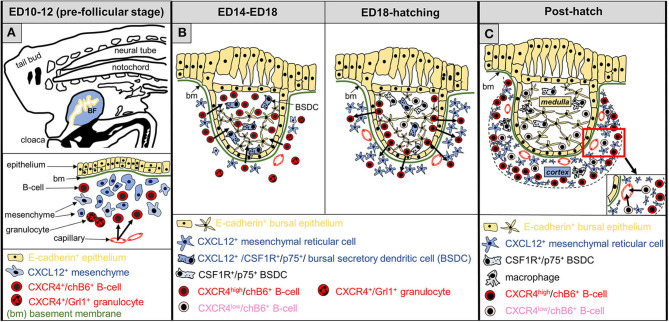Figure 10.
Schematic representation of CXCL12-CXCR4 functions during development of the bursa of Fabricius. (A) At the pre-follicular stage, B cell precursors (chB6+), expressing CXCR4 (red color) are attracted to the bursa anlage (arrows), where yet undefined mesenchymal cells produce CXCL12 (blue). Granulocytes, present in the bursa mesenchyme, also express CXCR4. (B) The follicular stage of the bursa is divided into two parts: B-cell immigration into the follicle bud (left) and development of the follicle cortex (right). Bursal secretory dendritic cells (BSDC) are the first hematopoietic cells entering the follicle buds. In the early follicular phase, CXCL12-expression pattern changes, and BSDCs become CXCL12+. At this stage, CXCR4+-B cells, but not granulocytes are attracted into the developing follicles. During the next days of bursal development, while strong intra-follicular B cell proliferation takes place (not shown), CXCL12 expression is relatively homogeneous Around hatch, CXCL12 expression declines in the follicle (BSDC lose CXCL12 expression) and increases outside of the follicle bud next to the basement membrane. At this stage, some CXCR4+ B cells cross the basement membrane to establish the follicular cortex, separating the follicle into a CXCL12-high cortex and a CXCL12-low medulla. (C) Shortly before hatch, CXCR4 expression on B cells becomes more heterogeneous and CXCR4-high and CXCR4-low B cells (pink) are distinguishable. After hatch, cortical CXCR4-high B cells are retained in the bursa, while CXCR4-low B cells are located near the cortical-medullary border and start to emigrate from the bursa via cortical blood vessels.

